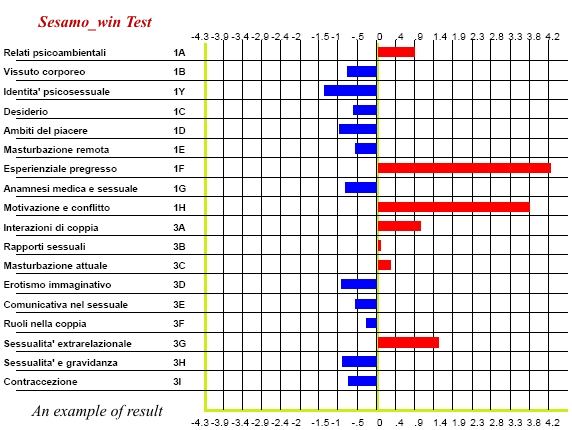 | ||
SESAMO is the acronym of Sexrelation Evaluation Schedule Assessment Monitoring, is an Italian psychometric and psychological standardised and validated questionnaire (see Tab. 1) to examine single and couple aspect life, sexuality, interpersonal and intimate relationship.
Contents
Features
As many others sexological tests, a female and a male version are available and both are made up of three sections (see Tab. 2):
Contents
The two versions (male/female) and their subsection (single/couple) of the questionnaire, contain 135 items for male and female single people, and 173 for males and females with a partner respectively. This method allows to detect dysfunctional sexual and relational aspects in singles people and people with a partner, aiming at two main goals:
Assessment
The assessment essentially aims at those areas concerning previous and present sexuality and, at the same time, it takes into consideration all those elements that, even indirectly, could have affected the development, expression and display of personality, affectivity and relationality (interpersonal and intimate relationships).
The questionnaire takes into consideration the following areas (as shown on Tab. 2):
social environmental data, psychosexual identity, sphere of pleasure (sex play, paraphilias), previous and present masturbation, previous sexual experiences, affective-relational condition, sexual intercourse, imaginative eroticism, contraception, relational attitude; additional areas are intended only for subjects with a partner: couple interaction, communicativeness within the sexual sphere, roles within the couple and extrarelational sexuality (i.e. outside couple sexuality).
Methodology
The SESAMO_Win methodology is provided with a software for administering the questionnaire and creating a multifactorial multilevel evaluation Report. This software analyses and decodes the answers obtained through direct administration on the computer or entered into the computer from printed forms and produces an anamnestic report about the subjects' sexual and relational condition. Once the administration has been completed, the software does not allow the questionnaire and its respective report to be altered or manipulated. This is necessary for deontological reasons and, above all, to assure its validity in legal appraisals and screenings. The software processes a report for each questionnaire. Each report can be displayed on the computer monitor or printed out. It is also possible to print out the whole report or its single parts.
Anamnestic report
The report is divided in 9 parts:
It contains the subject's identification data and some directions for using the information in the report properly (interpretations, inferences and indications provided by the report).
It displays a summary of personal data, BMI (Body mass index), the starting and finishing time of the administration, the time required to fill in the questionnaire, the composition of the household, the present affective-relational condition and off-the-cuff comments from the subject at the end of the administration.
A diagram displays a comparative summary of the scores obtained by the subject in each area of analysis (it could be defined as a snapshot of the subject's sexual-relational condition). The right side of the diagram (displaying positive scores) indicates an hypothesis about the degree of discomfort/dysfunction for each area.
The critical traits section highlights the most relevant and significative features of the subject's condition and his/her sexual-relational fields. These indications allow to get some relevant hints to be used in prospective in-depth medical, psychological, psychiatric interviews.
It tells in a narrative and detailed way the subject's sexual-relational history, through the explanations and comments he/she made while completing the questionnaire.
It gives some brief indications about those focal points which need to be addressed and carefully considered, besides it suggests prospective specialist examinations and counselling.
This section of the report displays, as well as the topic relative to each question, the indexes of subliminal factors measured on the subject and the significance degree of the answers he/she has chosen for each item.
This section displays all the answers chosen and entered into the computer by the subject while completing the questionnaire; as well as being a documental report (official certificate), it can be used in personalised close examinations and to obtain the open answers entered through the keyboard by the subject.
Criticism
The disadvantages of this device are the time required for filling in the questionnaire (30–60 minutes) and the fact that the complete report can be elaborated only by the software. A reduced version of the questionnaire has less items but can be administered and scored through the paper and pencil method.
A clinical research that has used the brief version, expresses this:
"During follow-up each patient received the SESAMO test (Sexuality Evaluation Schedule Assessment Monitoring) in the standard clinical form, with the end point of tracking down the sexual, affective, and relationship profile of each Htx pts [...]. The SESAMO questionnaire is based on topics relative to male and female sexuality in mates situation. Topics are grouped in two section: the first one collects data on former sexuality, health history, and social behavior; the second one looks at the mate's relationship to show any situation revealing sexual worries. The questionnaire gives values based on a survey of 648 people with characteristics quite similar to the Italian population. The clinical test for mates is based on 81 items for males and 85 items for females. The row score for each topic is modified in standard scores. The exceeding of scores over a specified threshold gives concise information for diagnostic purpose".
